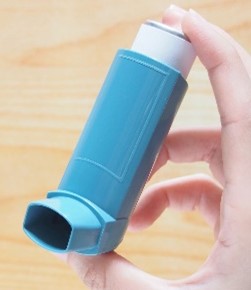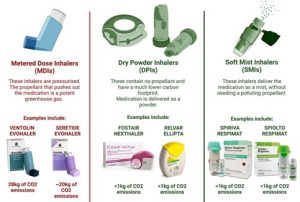Asthma article 3: Better asthma control = reduced environmental impact
Some types of inhalers have a bigger impact on the environment than others. However, the most important thing is that your child's asthma is kept under control by using the inhaler that works best for them. Better controlled asthma will improve your child's quality of life, but will also help to reduce the environmental impact. If their symptoms are well managed, they will need to use their reliever inhaler less frequently .
The most commonly used inhalers in the UK are pressurised metered dose inhalers (pMDIs). These have a metal cannister in a plastic container. You press on the cannister to release the medicine, along with a propellant gas, which carries the medicine into the airways in a fine spray. The gases used in pMDIs can contribute to global warming.
Other types of inhaler are becoming available that do not contain these gases and are less damaging to the environment. These include dry powder inhalers and soft mist inhalers such as Respimat. The carbon footprint of dry powder inhalers is at least 10 times lower than that of pressurised metered dose inhalers (pMDIs). The medicine itself does not harm the environment and the propellant gas does not cause any harm to the person using the inhaler.
What action can you take, whilst keeping your child safe?
- Although some inhalers are better for the environment, the number one priority is the safety of your child and ensuring that they use the inhaler that works best for them.
- It is important that your child continues to use their daily inhalers as usual (see our first news item), to keep their asthma symptoms under control.
 Keeping asthma symptoms under control should in turn limit how often your child needs to use their ‘reliever inhaler’. Reliever inhalers are usually blue.
Keeping asthma symptoms under control should in turn limit how often your child needs to use their ‘reliever inhaler’. Reliever inhalers are usually blue.- The reliever inhaler relieves wheezing caused by cold or exercise, and relieves the symptoms of an asthma attack when it first starts.
- The most commonly used reliever inhalers in the UK are the blue salbutamol pMDIs.
- These types of inhalers have been found to have a very high carbon footprint.
- Research has found that there is significant variation in the environmental impact from different brands of reliever inhalers.

Can anyone use a dry powder inhaler?
- Current guidance recommends promoting better asthma control for children and young people rather than collectively switching everyone to using dry powder inhalers.
- This is because the dry powder inhalers can result in poorer asthma control for some children.
- Children and young people who need to use pressured metered dose inhalers (pMDIs) should continue to do so, but older children and teenagers might be able to try a greener dry powder option. It is recommended that they speak to their GP or asthma nurse if they are interested in discussing a dry powder inhaler.
- Stopping or switching inhalers without speaking to a medical professional is not safe.
- It is essential that your child should still use their inhaler as directed if they have asthma symptoms.
- An asthma attack can get worse very quickly if an inhaler is not used. If your child’s asthma symptoms are not getting better, or they are struggling to breathe, take them to hospital immediately or call an ambulance.
Practical advice for using a reliever inhaler
- If you child needs to use their reliever inhaler frequently, ask your GP or asthma nurse for a medicine review in case they need additional preventer medicines to control their symptoms.
- Better control of asthma means that that your child will need to use their reliever inhaler less often.
- Next time your child has an asthma review, you might ask whether your child can have a different brand of reliever inhaler with a lower environmental impact. Or they might be able to have their asthma medicines in a dry power inhaler. As previously mentioned, these are not always suitable for children.
- Your child’s doctor or nurse should show your child how to use any inhaler that is prescribed for them, including how to use a spacer device.
- You can find helpful resources on Medicines for Children and the Asthma + Lung UK website. You can ask your child’s asthma nurse or doctor to check their inhaler technique to make sure that they are using it properly.
- Take old inhalers to your pharmacy to dispose of – do not put them in the household rubbish or recycling bin as the propellant may leak out over time. Pharmacies dispose of inhalers in a way that destroys the propellant without harming the environment.
NICE (the National Institute for Health and Care Excellence), which advises the National Health Service about best practice, has developed a decision aid to support patients in their discussions with healthcare professionals, which you can find here.
